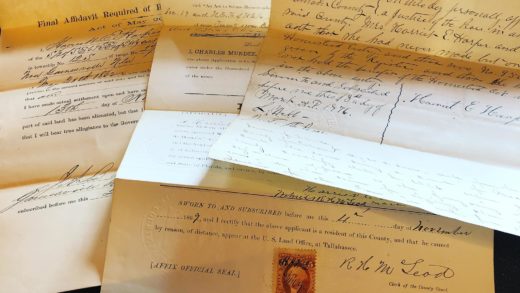I recently learned about a book named “Census” Department of the South November, 1864 For Jacksonville, Fernandina and St. Augustine, Florida Ordered by the Department of the South, Hilton Head, South Carolina by the Florida State Genealogical Society.
A super long title that doesn’t really say much about the contents.
But what is inside this book is amazing! I jumped at the opportunity to purchase it as there are limited copies available and the book, while at some libraries, isn’t at my local library. This book falls into the “must own” category for those researching their African American genealogy in this part of Florida as well as understanding the historical context of the Civil War through the people who lived during that time.
This special census data opens a unique window on Florida’s Civil War population that has heretofore been closed.
Robert A. Taylor1
This book only covers three areas in eastern Florida – Fernandina, Jacksonville, and St. Augustine. According to the Foreword written by Robert A. Taylor, this is a special census conducted on the orders of Federal military authorities.2 Part of Lincoln’s Ten-Percent reconstruction plan was to allow a new state government to be formed when 10 percent of the eligible voters had taken an oath of allegiance to the United States.3 Taylor believes this census is likely part of Lincoln’s reconstruction plan, despite the fact African-Americans did not yet have the right to vote in 1864. He also believes this could have been a way for the Union military to recruit for the new United States Colored Troops regiments.4

As you can see in the column titles of the census, column 12 states “Oath of Allegiance Yes or No.”5 The other columns include (from left to right): Number, Names, Height Ft, Height In, Eyes, Complexion, Age, Where born or contraband, Where registered for draft or former owner, Date into Department, Oath of Allegiance, Number of Rations, and Remarks.6
The book details the census using the columns above but includes a column before Number called Page. The Page column lists the page number of the census in which the person is listed. The Number column is the order the person’s information was taken for that page. According to the Introduction written by Pamela J. Cooper and Kathleen K. Graham, the original census pages were not numbered, but to create this index, they numbered the copy at the Indian River County Main Library, in the order they were photocopied from the National Archives.7
The next five columns after the name contain vital information. The next column, Where Born or Contraband, is interesting as the introduction to the book does not really explain what “contraband” means. The meaning of contraband in this case indicates an enslaved person. At the time this census was conducted, the 13th Amendment had passed through Congress but not passed in the House.8
The next two columns, Last Residence and Where Registered for Draft or Former Owner, simply states where the person lived last before this area and lists the owner of the formerly enslaved person or where they registered for the draft, if not enslaved.
The following three columns, Date Into Department (area), Oath of Allegiance, and Number of Rations, explains when the person came into the area, whether they took an oath of allegiance and if they are receiving rations.
In the final column, Remarks, the introduction states the census taker recorded the occupations of some individuals, including bricklayers, butchers, shoemakers, clerks, and more. That same column also indicated those who were destitute, old, feeble or sick. Disabilities, deserters, prisoners, and some family relationships were recorded as well.9
This book is very well organized and easy to follow. The editors have broken the census up by population and area, listing the page numbers for each. In addition to this, they have included two indexes. The first index is for each person who is enumerated on each page. The second index is of all listed former owners of enslaved people.
Every good genealogist knows indexes are a derivative source. It’s always a good idea to view the original, when possible. In this case, it actually is possible to view the original and photocopies at the locations below:
- National Archives – Record Group 393, Item 4289
- Florida State Archives
- Jacksonville Public Library
- St. Augustine Historical Society
- Indian River County Main Library
I hope to obtain a copy for the Flagler County Historical Society on my next trip to Washington, DC.
Finally, if you’re interested to see if your ancestor’s name appears in the book, you can use Amazon.com’s “Search Inside” feature! I can’t guarantee you will be able to see the page but you will be able to see the page number. It’s a great way to search “Census” Department of the South November, 1864 before you buy or go to the library.
“Census” Department of the South, November, 1864: For Jacksonville, Fernandina, and St. Augustine, Florida (Bowie, MD: Heritage Books, 2002), Pg v. ↩
Ibid. ↩
“Lincoln issues Proclamation of Amnesty and Reconstruction.” History.com (https://www.history.com/this-day-in-history/lincoln-issues-proclamation-of-amnesty-and-reconstruction : 20 Jun 2020). ↩
“Census” Department of the South, November, 1864: For Jacksonville, Fernandina, and St. Augustine, Florida (Bowie, MD: Heritage Books, 2002), Pg v. ↩
“Census” Department of the South, November, 1864: For Jacksonville, Fernandina, and St. Augustine, Florida (Bowie, MD: Heritage Books, 2002), Pg xi. ↩
Ibid. ↩
“Census” Department of the South, November, 1864: For Jacksonville, Fernandina, and St. Augustine, Florida (Bowie, MD: Heritage Books, 2002), Pg vii. ↩
“13th Amendment to the U.S. Constitution: Abolition of Slavery (1865).” Our Documents (https://www.ourdocuments.gov : 20 Jun 2020). ↩
“Census” Department of the South, November, 1864: For Jacksonville, Fernandina, and St. Augustine, Florida (Bowie, MD: Heritage Books, 2002), Pg x. ↩






Recent Comments